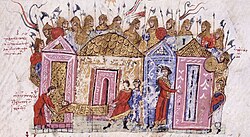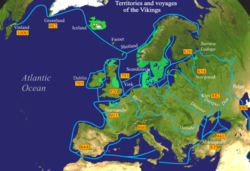Varangian Guard
The Varangian Guard (Greek: Τάγμα των Βαράγγων, Tágma tōn Varángōn) was an elite unit of the Byzantine Army, from the 10th to the 14th centuries. Their members served as personal bodyguards to the Byzantine Emperors. At first they were made up of Vikings or Rus. Later, after the Norman conquest of England, Anglo-Saxons joined the guard. For a time it caused an Anglo-Saxon emigration to Byzantium).[1]
History
In 874 peace was established between the Kievan Rus' and the Byzantine Empire.[2] Kiev sent military assistance to Constantinople. By the early 10th century Kievan Rus were serving in the Byzantine army. In the summer of 987 the emperor Basil II asked for military help from Vladimir the Great, Grand prince of Kiev.[2] Vladimir sent 6,000 men who arrived in the winter of 987. These were soldiers who had not been paid and wanted to go to Byzantium where they hoped they could get pay. During Basil's campaigns the Varangians proved to be an excellent fighting force.[2] When Basil campaigned in Georgia and Armenia, he took 6,000 Varangians with him. During truce talks a Varangian and a Georgian got into an argument. General fighting broke out and many were killed on both sides. The surviving Varangians formed the Varangian Guard.[2] They wore uniforms of blue tunics with bright red cloaks.[3] They carried long handled battle-axes trimmed with gold. These weapons were their trademark. The sight of these axemen on a battlefield meant the Emperor was near.
Varangian Guard Media
Viking expeditions (blue line): depicting the immense breadth of their voyages through most of Europe, the Mediterranean Sea, Northern Africa, Asia Minor, the Arctic, and North America. Lower Normandy, depicted as a ″Viking territory in 911″, was not part of the lands granted by the king of the Franks to Rollo in 911, but Upper Normandy.
The Byzantine cross, on U 161, a cross which is today the coat of arms of the municipality of Täby, Sweden
One of the runic inscriptions in Hagia Sophia, probably carved by members of the Varangian Guard
References
| Wikimedia Commons has media related to Lua error in Module:Commons_link at line 62: attempt to index field 'wikibase' (a nil value).. |
- ↑ Sandra Alvarez (23 June 2014). "English Refugees in the Byzantine Armed Forces: The Varangian Guard and Anglo-Saxon Ethnic Consciousness". DE RE MILITARI. Retrieved 16 August 2015.
- ↑ 2.0 2.1 2.2 2.3 Raffaele D'Amato, The Varangian Guard 988-453 (Oxford; Long Island City, NY: Osprey, 2010), pp. 6–7
- ↑ Ryan Stone (29 May 2015). "The Varangian Guard: Berserkers of the Byzantine Empire". Ancient Origins. Retrieved 16 August 2015.





